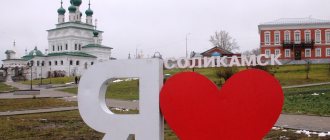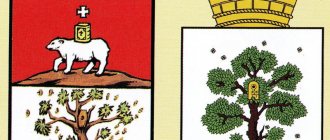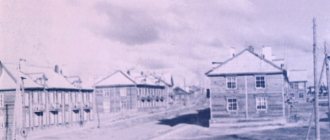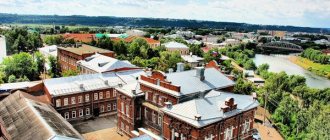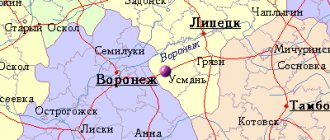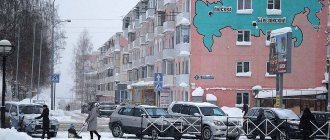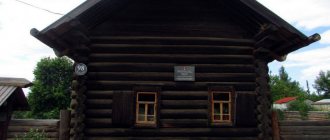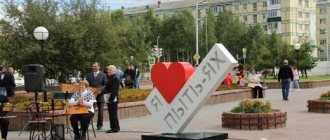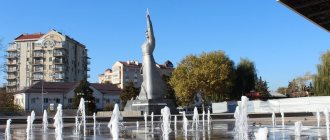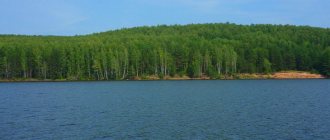Solikamsk is one of the oldest cities in the Urals, with enormous tourism potential. At the same time, Solikamsk is the third largest city in the Perm Territory (its population is about 100 thousand people).
Coordinates for GPS navigator
59.648333, 56.771029
Solikamsk city on the map
As you might guess from the name, the city was founded by salt. In 1430, Vologda merchants Kalinikovs organized salt mines here. On the banks of the Usolka River (a tributary of the Kama), brine-lifting pipes and brewhouses were built for evaporating salt. Now you can clearly understand how everything was arranged in the Borovsky Salt Museum in Solikamsk or in the Khokhlovka Architectural and Ethnographic Museum near Perm.
Thanks to the salt, the settlement quickly grew and developed, soon becoming the salt capital of Russia. Salt was very valuable at that time (no worse than oil today).
The importance of Solikamsk grew greatly with the opening of the Babinovskaya road to Siberia here (a milestone in memory of the Babinovskaya road can now be seen on the city’s Cathedral Square).
In the 20th century, the largest deposits of potassium and potassium-magnesium salts were discovered here. The potash industry is currently the main pillar of the city's economy.
Solikamsk is included in the list of historical cities; it has many cultural and historical attractions, including federal ones. Thousands of people come here every year to see them, including guests from other countries.
Let us dwell on the most interesting sights of the city, among which temples predominate. In total, there are 12 stone churches in Solikamsk, each of them has its own history and its own characteristics; we will tell here only about the most beautiful and interesting ones.
Holy Trinity Cathedral in Solikamsk
This old five-domed cathedral in the historical center of Solikamsk was built in 1684-97.
It was the main temple of the city. A round tile with the image of a double-headed eagle was installed in the southern wall of the temple, and on the western wall there was a relief crown made of brick. Only the crown has survived to this day. The Holy Trinity Cathedral is distinguished by its rich decoration; its stone lace is very beautiful. The two massive porches of the temple are also interesting. In 1929, the temple was closed and a museum was placed here. During the Great Patriotic War, it received valuable evacuated exhibits from the central part of the country. Currently, the history department of the Solikamsk Museum of Local Lore is located here. Museum phone number: +7 (34253) 54518.
Holy Trinity Cathedral is an architectural monument of federal significance, one of the main symbols of Solikamsk.
History of the city of Solikamsk
Source of historical information about the city of Solikamsk: V.V. Kostochkin “Cherdyn, Solikamsk, Usolye.” M. "Stroizdat", 1988
Solikamsk is much younger than Cherdyn. There was a time when the name of this picturesque town, which has now become a major industrial center of the Kama region, was not only written, but also pronounced separately. The largest river in the Urals, the Kama River, and table salt, mined on the Usolka River flowing into it, gave Solikamsk life and a colorful name.
The history of Salt Kamskaya is the history of the development of distant Siberia, the history of the development of the salt industry in Rus' and the development of the natural resources of the vast Perm region.
It is assumed that the foundation of Salt Kama, which later became famous thanks to its rich salt mines, was laid in 1430, when the enterprising townspeople Kalinikovs, who organized the boiling of salt on the Borovitsa River, above the village of Borovoye, due to the weak concentration of the salt brine obtained there, moved their simple fishing equipment to the south, to the shore of Usolka, where the occurrence of salt layers was less deep and the strength of the brine was much higher. At the end of the 15th century, a small fishing village was formed here on Usolka. True, at the beginning of the next century this village was devastated by the Tyumen people, who captured its few inhabitants, but despite this, it quickly resumed its activities, and in 1558 it received wooden fortifications and thereby turned into a city.
In 1559, most of the wooden buildings of Sol Kama burned down, but the city was soon rebuilt. According to the scribal book of Ivan Yakhontov, compiled in 1579, there were 190 philistine households, 26 trading shops, 16 salt pans and 201 inhabitants - people from Vologda, Veliky Ustyug, Ust-Sysolsk, Balakhna and Cherdyn. It then became the center of the vast Usolsky district, the population of which, while boiling salt in the settlement, was also engaged in collecting firewood for the boilers, agriculture, handicrafts and trade. Only the unexpected attack of the Pelym prince Kikhek in 1582, during which the Solikamsk pasad was burned, part of the Solikamsk residents were killed and neighboring villages were destroyed, suspended the life of the city, but its restoration did not last long this time either.
With the final annexation of Siberia and the increased settlement of the Northern and Middle Urals, the number of Solikamsk residents, despite the harsh climatic conditions and low soil fertility, begins to steadily increase. The growth of the salt mining industry in Kamskoye Usolye is increasingly increasing the economic importance of the city. The “sovereign Verkhoturskaya road” has a special influence on its development, which turned Sol Kamskaya into the main transshipment point in front of the Ural ridge. Coachmen appear in it, conducting caravans to Verkhoturye and back, it becomes an important transport hub on the “sovereign Verkhoturye road”.
In 1614, the Moscow government even gave orders to the governor of nearby Cherdyn to carry out repairs to the Solikamsk fortifications, so that “thieves’ people” would not come to “the city and the fort unknown and do something bad.”
At the beginning of the 17th century, the advantageous location of Salt Kama on the “sovereign” road, which firmly connected the center of the country with distant Siberia, affected its development even more strongly. ...
Judging by the scribe book of Mikhail Kaisarov, compiled in 1624, in Solikamsk at that time there were 357 households, 67 shops, 37 varnitsa and more than 620 only male residents.
Sol Kama began to develop especially intensively in the second quarter of the 17th century, after a huge fire in 1635, which destroyed 11 churches and left only a “small matter” in three places on the settlement. Simultaneously with the development of the country's national economy, the city of Solikamsk is also developing. Among Solikamsk salt workers there appear people who are strangers to Solikamsk Posad. Having accumulated funds in the sphere of exchange and trade, they invested money in the Solikamsk salt mines, which were then the main source of wealth of the city and surrounding lands. As a result, the number of salt brewhouses of Kama Salt began to increase rapidly. The administrative role of the city is also expanding. In 1636, the governor’s residence was transferred here, from Cherdyn, to the former Cherdyn “suburb,” and control of the entire region was concentrated.
The industrial development of the city was not affected even by terrible fires, which were the result not only of the lack of basic fire-fighting conditions during salt boiling, but also of deliberate arson, caused either by the revenge of desperate working people, or by the competition of salt industrialists who did not disdain any means to cause damage to their business rivals . They destroyed not only individual streets with their houses, outbuildings, industrial buildings and churches, but also the entire city as a whole. Such a fire in 1672 destroyed the city almost completely.
However, Kama Salt, like a phoenix, always rose from the ashes. According to the census of 1678–1679, in Solikamsk Posad there were 513 households of local residents and 318 huts that belonged to people who came to the city to work. The total number of inhabitants was 2257 males only.
By the end of the 17th century, Sol Kama turned into the largest salt-making center of the state: more than 200 saltworks were already operating in it and its surroundings.
And at the end of the 17th century, when Sol Kama, playing a leading role in the life of the Urals, reached the zenith of commercial and industrial development, large stone construction began there.
Religious buildings were then built mainly from stone (brick). They were placed both in the city center and on its outskirts. Solikamsk residents erected them as usual on the sites of old churches destroyed by fires in 1688 and 1695. These were separate structures, but some of them later became the basis of architectural complexes. Along with richly decorated stone churches, stone residential buildings of wealthy residents also appeared on the streets of Solikamsk.
Such extensive construction as unfolded in Solikamsk at the end of the 17th century had never happened in the Kama region. Having introduced new elements into the artistic appearance of the city, the main buildings of which still remained wooden, it continues at the beginning of the next century, gradually spreading beyond its borders. Thanks to him, the famous salt mine becomes the main center of construction culture throughout the region, the trendsetter of its artistic fashion. It is experiencing the most rapid period of its development. His fame spreads throughout the country. His buildings are known in Moscow and spoken about in the cities of Siberia.
Along with the “stone builders,” local painters also worked in Solikamsk at the beginning of the 18th century, carpenters, joiners and woodcarvers worked, blacksmiths, potters and other artisans produced their products. Their fruitful activity on city construction projects soon attracted the attention of Peter 1, who then began hastily building a new state capital on the Neva. And it is no coincidence that in 1703, by royal decree, Solikamsk blacksmiths were sent to Tikhvin and Taganrog “to the city building”, and in 1710, Solikamsk carpenters, joiners and boilermakers were taken to St. Petersburg construction sites.
Then Peter 1 paid attention to Solikamsk itself, which had already changed greatly. In 1722, by his order, even the “academy teacher” Stepan Zherebtsov was sent to the city, obliged to teach the children of local residents “arithmetic and geometric sciences.” This was the period of the highest development of the “salt capital” of the Russian Empire, the time of its rapid economic recovery and cultural growth. The city at that time already occupied a significant territory and was larger than at the beginning of the 18th century...
Large construction works were carried out in Solikamsk in the third quarter of the 18th century. However, this time they were caused not so much by the growth of the city’s economy, but by two enormous fires that followed each other in mid-1743.
The July fire of 1743 was especially severe, taking 16 lives and destroying 700 town houses, not counting the shopping arcades and the large bridge across Usolka, as well as public buildings. After this fire, which even melted the bells of two churches, only two wooden churches and 20 houses survived in Solikamsk. It was a terrible disaster that caused the departure of many fire victims to Kungur, Stepanovo fortification and Cherdyn... However, rather, the city rose again from the ashes. Not only the courtyards of its eminent residents and the houses of ordinary people were rebuilt, but also all the burnt stone churches, with their chapels and bell towers, were repaired, on which new bells were soon hung; they were specially cast in 1746 and 1747 in Cheboksary.
During this colossal restoration construction, interrupted by smaller fires in 1753 and 1759, the general planning structure of the city began to be streamlined. Its blocks become even more rectangular, its streets and alleys become wider and more rectilinear.
This was also a turbulent period in the construction development of the famous trade, as during the late 17th and early 18th centuries. The construction of the office building in 1781 and the approval of the Solikamsk coat of arms in 1783 (a salt well with a bucket lowered into it on a golden background) were, as it were, its final stage.
However, in the second half of the 18th century, the salt-making industry of Salt Kama, which had developed so much towards the end of the 17th century, no longer played a significant role in the city’s economy. From the beginning of the 18th century, due to the introduction of a state monopoly on salt in 1705 and changes in the conditions of its production and sales, the share of the Solikamsk industry began to rapidly decline. The sharp decline in local salt production was also facilitated by the growth in open-pit extraction of self-planted salt from the Volga lakes Elton and Baskunchak. This led to a decrease in the number of Kama Salt breweries. Some of them were simply not restored after the fires. And if in 1724 there were 44 saltworks in Solikamsk Posad, then in 1743 there were only 34 of them, and in 1760 their number dropped to 23. The city is losing its significance as the main center of Russian salt production, which, due to the creation of a large metallurgical industry, ceases altogether to be the leading site of Russian production, and in 1816 there was no longer a single operating brewery left in it.
With the advent of the new Siberian route, which passed from Kazan through Perm and Kungur to Yekaterinburg, founded in 1721, Solikamsk by the end of the 18th century also lost its significance as a shopping center (it became apart from this route). With the transfer of the provincial chancellery to Kungur in 1738, Solikamsk ceased to be the administrative center of the region.
Today Solikamsk is a major center of modern chemistry, but the city has still retained the basis of the old regular layout.
Epiphany Church in Solikamsk
The five-domed Epiphany Church with a bell tower was built in 1688-95 at the expense of parishioners in the Moscow Baroque style. The facades of the church are decorated with rich stone carvings. In 1934 the church was closed, then in 1943-62 services were held here again. Currently, in the Church of the Epiphany there is a department of ancient Russian art of the Solikamsk Museum of Local Lore. One of the most valuable exhibits is the icon of St. Nicholas, given, according to legend, to the residents of Solikamsk by Ivan the Terrible. Inside the temple, the church decoration has been preserved, and the wooden carved iconostasis has been restored. Here you can see ancient icons of the 17th - 18th centuries. Recently the temple was restored, becoming a real decoration of the city.
How to get to the city of Solikamsk:
The route is designed for standard passenger cars.
The distance from Ekaterinburg is about 570 km, from Perm - about 210 km. You can travel from Yekaterinburg to Solikamsk in two ways:
1) From Yekaterinburg we leave towards Nizhny Tagil. N. Tagil we pass along the bypass road - after passing the town of Verkhnyaya Tura, we follow the signs towards the town of Chusovaya, Perm Territory, focusing on the village of Promysla. Next we pass Promysla - Gremyachinsk - village. Usva - Solikamsk.
2) From Yekaterinburg we leave towards the city of Perm - then we go to the city of Solikamsk.
The distance in both cases is approximately the same, about 570 km..
Combine trip:
Traveling around the Perm region by car.
Voivode's House in Solikamsk
The voivode's stone house, built in 1688, is very interesting. This is the oldest stone civil structure in the Perm region. The thickness of the walls of the house reaches two meters. The building has preserved internal passages and loopholes. In addition, several underground passages led from the governor’s house. Now here is the historical department of the local history museum: here you can get acquainted with the early history of the city and see the interior of the 17th-century executive hut.
Development of transport infrastructure
The total length of roads in Solikamsk is 326.6 km, and with hard surfaces – 261.2 km. A regional highway runs through the city, along which intercity buses travel. Nowadays, motor transport is the main type of intercity transport, which creates a large load on this transport network. Within the city, this was facilitated by the growth in the number of cars and road freight transport.
Therefore, an important direction in the development of the transport network is to improve the quality of intracity roads and carry out timely repairs.
The problem of providing railway transport is also acute. To meet these goals, it is planned to implement a project for the construction of a bypass section of Berezniki and the Belkomur line.
Ust-Borovsk salt plant - salt museum
Solikamsk bears its name for a reason.
The city was founded during the salt mines on the banks of the Usolka River. Its name has always been associated with salt: Usolye on Kamskoye, Usolye Kamskoye and even simply - Kamskaya Salt. Today, at the former Ust-Borovsky plant there is a museum where visitors can learn the history of salt production in our country in the 17th-20th centuries, and at the same time explore a unique historical and architectural complex - a monument of wooden architecture in the open air. Address: st. Newspapers Zvezda, 2. Website.
Ust-Borovsk salt plant
Team Nomads
From July 19 to July 29, 2013, Team Nomads rafted down the Vishera River, and at the same time visited some interesting places in the Perm Territory , Udmurtia and Tatarstan.
The hike was successful, I was especially pleased with the weather in the Northern Urals, it was almost always warm, there were thunderstorms, but there was no prolonged bad weather! It should be noted right away that you should go to the Perm region via M-7 - Elabuga - Izhevsk - Perm. Since the roads in the Kirov region are very bad. From Perm towards Solikamsk, and then to Krasnovishersk. You should definitely see the city of Solikamsk, as it is a very interesting and beautiful city in the Perm region! Nomads have been here 2 times! MONUMENTS OF GEOLOGY OF THE PERM REGION - HERE!
ATTRACTIONS OF THE PERM REGION - HERE!
GEOGRAPHY OF THE PERM REGION - HERE!
NATURAL MONUMENTS OF THE PERM REGION - HERE!
CAVES OF THE PERM REGION - HERE!
TREASURES OF THE PERM REGION - HERE!
ANOMAL ZONES OF THE PERM REGION - HERE!
Central square in Solikamsk and beautiful ancient temples
After rafting along the Vishera we go to Solikamsk, where we have a city tour. The city has many ancient temples in the northern style and many architectural monuments!
We also visited the Salt Spring, where we took a swim.
Solikamsk is a city in the Perm region, the administrative center of the Solikamsk municipal district, the third largest city in the Perm region, has the status of an urban district. The city is located in the marginal zone of the East European Plain on the territory of the Pre-Ural foredeep near the left tributaries of the Kama - the Usolka and Borovaya rivers. The final railway station is Solikamsk on the Chusovaya - Solikamsk line. The distance to the regional center is 202 km (by road), 368 km (by rail, via Chusovskaya station). Port of the Kama Reservoir. It occupies an area of 165.5 km², the population is 97,063 people (as of January 1, 2011). The head of the city is Sergei Devyatkov (since 2006).
History Salt gave life and name to Solikamsk. The city arose during the salt mines, organized by merchants Kalinikovs who came from Vologda. Around 1430 they built brine pipes and brewhouses on the banks of the Usolka. Initially, the city was called in the chronicle of 1506 Usolye on Kamskoye, later Usolye Kamskoye, and from the 17th century Sol Kamskaya.
E. Korneev. Saltworks in Solikamsk. 1810
Cathedral bell tower. One of the symbols of Solikamsk
Industrial structures - pipes, towers above them, chests for storing brine, brewhouses, barns - were the first buildings of the new settlement. In 1472, the lands in the upper reaches of the Kama, together with Perm the Great, joined the Grand Duchy of Moscow. Favorable geographical location and rich reserves of salt springs. The city suffered more than once from raids by nomadic tribes and fires, but was always restored. According to the scribe books of the 1620s, there were 16 forges in Solikamsk, mainly serving salt-making industries; in the 1630s, deposits of copper ore were discovered near the city and the Pyskorsky copper smelter was established. In the 17th century Solikamsk, which was a major transit transshipment point on the way to Siberia, became an important economic and administrative center. A big role in this was played by Artemy Babinov’s discovery of a direct road to the upper reaches of the Tura River and the founding of the city of Verkhoturye (1597). Since 1613, a voivodeship government was established in Solikamsk (until 1780). By the end of the 17th - beginning of the 18th centuries. Solikamsk was the largest saltworks in Russia. At that time, Kama salt provided more than half of all salt sold in the country. By the end of the 17th century, with the establishment of trade relations with China, Solikamsk became a transit and trade center between Moscow and Beiping (Beijing); A large stone construction project is underway. During this period, Solikamsk was the most significant commercial and industrial city of the Kama region; its economic importance went far beyond the Urals. In the 17th century The copper smelting industry is developing. Near the village of Grigorovo, near Solikamsk, mines were founded in 1633, and in 1634 the first copper smelter in Russia was built (in 1635 it was moved to Pyskor). In 1731, 2 km from Solikamsk, the Turchaninovs built a second copper smelter, and near it in 1742 - a copper utensils factory (sets for the imperial family and samovars were made). At the end of the 17th century. Sol Kama reached the zenith of commercial and industrial development, playing a leading role in the life of the Urals, being a transit trade, customs, military-administrative and religious center. In connection with the growth of open-pit mining of salt in the Volga region and the emergence of a new Siberian route by the end of the 17th century. the city loses its significance as a shopping center and the main center of Russian salt production and turns into a county town.
flag of Solikamsk
In 1731, in the village of Krasnoye near Solikamsk, Grigory Demidov created the first private botanical garden in Russia, and in the late 60s. XVIII century A.F. Turchaninov in his estate has a second botanical garden, which is of great scientific, practical and educational interest. By the beginning of the 19th century. In the city there was a soap factory, a glass factory, 7 tanneries, and a handicraft bell factory. By the middle of the 19th century. trade dies down. However, from the second half of the 19th century. a new economic upswing in Solikamsk begins, old salt factories are improved and new salt factories are built (in 1860, 164.4 thousand pounds of salt were boiled down, in 1900 - 3.4 million pounds). By the end of the 19th - beginning of the 20th centuries. in the city there were 2 tanneries, 5 establishments for the production of leather goods, a carpentry and iconostasis enterprise, 2 brick factories and a winery, over 20 forges, 24 trading establishments and a bank were opened; barges were being built. At the beginning of the 20th century. in Solikamsk there were women's and men's gymnasiums, 4 schools, a forestry school, 3 public libraries, and a cinema. On January 31 (February 13), 1918, Soviet power was proclaimed in Solikamsk, and the zemstvo and city governments were abolished. On February 25, 1918, the district center was moved from the city of Solikamsk to the village of Novoye Usolye. In November 1923, Solikamsk became the regional center of the Verkhne-Kama Okrug and at the same time lost its status as a city, becoming a village. By decree of the All-Russian Central Executive Committee of April 5, 1926, Solikamsk returned its city status. In September 1928, the administrative center of the Verkhne-Kama Okrug was moved from the city of Usolye to Solikamsk.
City of Solikamsk
In the 20s of the 20th century, Solikamsk was one of the centers of industrial development of all-Union significance. The only deposit of potassium-magnesium salts on the territory of the USSR becomes the center of industry development. In the 1920s, tens of thousands of political prisoners, special settlers, and exiles were forcibly brought to Solikamsk, with a population of 5,000 people. The city becomes one of the islands of the Gulag archipelago. During the time of Stalin's terror, thousands of repressed people were shot and buried in the area near Solikamsk. In 1941, 800 repressed Latvians from occupied Latvia were brought to Solikamsk, most of them died here. The Museum of the History of the Potassium Industry of Russia is working to study and preserve the memory of those repressed. During the years of industrialization, money from the Solikamsk carnallite plant circulated in the city, which became a bonistic rarity. Over time, the borders of Solikamsk expanded significantly; in 1959, the city of Borovsk, located in the north near the river, was included in its composition. Borovoy, 6 km from the center. With the development of the potash industry in the city, in the river valley. Klestovka, the modern microdistrict Klestovka grew up.
City of Solikamsk
Natural resources The city is located within the unique Verkhnekamsk deposit of potassium and potassium-magnesium salts. In the depths there are large reserves of sodium chloride salts.
Potassium ore The raw materials of the deposit are complex; the ore contains rare and trace elements: bromine, rubidium, cesium, magnesium, etc. Near the Solikamsk railway station there is a deposit of construction sands and a sand-gravel mixture. The natural resources of Solikamsk are rich in a diverse range of mineral waters of industrial and medicinal value. (also see Preobrazhensky, Pavel Ivanovich).
Economy Solikamsk is one of two economic centers of the Berezniki-Solikamsk industrial region, the territory of which is economically a single whole, which contributes to the development of close industrial and technical ties between enterprises in Berezniki and Solikamsk. In 2010, industrial enterprises of the city shipped goods of their own production and performed work and services in the amount of 49,444.6 million rubles at current prices. In general, the total volume of goods shipped, work performed and services provided in January-December of the current year increased by 1.1 times compared to the same period last year. The economic profile of the city is determined by the mining and chemical industry (extraction of potassium salts and production of mineral fertilizers) - OJSC Silvinit (since 2011 OJSC Uralkali), enterprises of the timber industry - OJSC Solikamskbumprom, logging plant, as well as the metallurgical industry - magnesium production, based on the processing of potassium-magnesium salts of OJSC Solikamsk Magnesium Plant. The city also has mechanical engineering enterprises (mechanical repair plant), construction organizations, food industry enterprises (meat processing plant, dairy plant, etc.), defense - the largest military-industrial plant in Eastern Europe, guarded by military personnel of military unit 3426-B. The most powerful industrial sector of the city is the potash industry. The design capacity of the 3 potash mines included in OJSC Uralkali is 3203.2 thousand tons of potash fertilizers per year. Currently, the city has great export potential due to the high level of development of basic chemistry and metallurgy (production of magnesium and rare earth elements). Today, the products of Solikamsk enterprises are supplied to more than 60 countries around the world. Solikamsk has great tourist and recreational opportunities.
Administrative division In territorial planning terms, the city is divided into the following parts: Southern part (the center, located mainly along the Usolka River, with a significant number of administrative buildings, architectural and historical monuments (churches, buildings of the 19th and early 20th centuries); microdistricts - Verkhniy and Nizhny Bolnichny, Krasnoye, 3rd microdistrict of potassium workers, Klestovka; as well as a number of large villages (Kaliyets, Shakhtyorsky, Rubtsovo), which are adjacent to the divisions of Uralkali OJSC, the magnesium plant and others.) Northern part - Borovsk microdistrict (in 1949 - 1959, a city gravitating towards the Solikamsk Pulp and Paper Mill and the Kama River) Between the southern and northern parts of the city is approximately 6 km. Between them there are industrial zones, warehouses, bases, gas stations, as well as garden plots.
City transport in Solikamsk Solikamsk is a major transport hub. The city has the Solikamsk railway station of the Perm branch of the Sverdlovsk Railway. From Solikamsk you can take a train to Moscow (trailer cars for the Malachite train), as well as to Yekaterinburg (Solikamsk-Ekaterinburg train). The movement of electric trains has been organized to the stations: Berezniki, Ugleuralskaya, Chusovskaya, Perm II. The city has a bus station that serves both suburban and intercity routes. By bus from Solikamsk you can get to Perm, Yekaterinburg, Berezniki, Cherdyn, Krasnovishersk, Nyrob, Kizel, Lysva, Aleksandrovsk, Nytva. City transport is represented by 22 bus routes. Minibus taxis have not taken root in the city. Home . Basically, routes are laid from the southern part of the city to the northern. There are 326.6 km of roads in municipal ownership, the length of paved roads is 261.5 km. Solikamsk is the largest road junction in the north of the region. Solikamsk urban district is connected by roads of territorial significance with the cities of Krasnovishersk and Cherdyn in the north, Berezniki, Aleksandrovsk, Kizel, Perm in the south.
chapel at the Epiphany Church Solikamsk
There is a closed airport 12 km from the city. Back in 2004, it was possible to fly from Solikamsk to Moscow, and in the summer there were flights to Anapa and Sochi. The city has access to the Unified deep-water system of the European part of Russia along the Kama River. In the future, Solikamsk will become a supporting link in the construction of the “highway of the 21st century” - the Belkomur road, which will connect the regions of Siberia and the Urals with ports in Arkhangelsk and Murmansk, shortening this route by 800 kilometers. After ground subsidence in Berezniki as a result of a man-made disaster, passenger traffic along the Yayva-Berezniki railway line was stopped. As a result, the cities of Solikamsk and Berezniki were left without railway connections with the outside world. The management of the Russian Railways company decided to build a new bypass railway line. Construction was completed in 2009, and in the spring of 2010 traffic was opened to bypass the dangerous area.
Tourism In 1970, the city was included in the list of historical cities, which includes 67 monuments of cultural history, 26 architectural monuments (23 of them are of federal significance), among which the leading place is occupied by the Trinity Cathedral. In addition, the city has a state museum of local lore with rich collections of coins, icons and other exhibits, a “Museum of Salt” and departmental museums. For 4 years now, the city has been hosting the festival of blacksmithing “Fires of Hephaestus”; it is also planned to hold a “Festival of Salt”. In 2010, the Ministry of Culture of the Perm Territory is conducting the program “Solikamsk is the salt capital of Russia.” In 2008, according to official data, the city of Solikamsk was visited by more than 10 thousand people (including foreign citizens and residents of Russia), mainly for cultural, educational and business purposes. In 2011, the Green Line excursion route appeared in Solikamsk.
Russian Orthodox Church Church of the Epiphany Church of the Presentation of the Most Holy Theotokos into the Temple Church of the Holy Myrrh-Bearing Women Church of the Image of the Savior Not Made by Hands. Built in 1689-1691. Church of the Transfiguration of the Lord (Spaso-Preobrazhenskaya) Cemetery Church of the Holy Righteous Simeon of Verkhoturye Holy Trinity Monastery John the Baptist (Krasnoselsky) Convent
Architecture and landmarks City of Solikamsk
Voivode's House in Solikamsk
The city is full of historical and architectural monuments, with a unique ensemble of churches from the 17th-18th centuries. Among the monuments of civil architecture: the voivode's house (1688, with keel-shaped multi-stage kokoshniks in the platbands); a two-story wooden residential building (early 18th century) near the Kremlin hill, on the embankment; the former estate of Turchaninov (1760-80s) with 3 surviving houses. In the trans-river part of Solikamsk, the former house of the merchant I. S. Lapin (late 18th century) has been preserved. In the 1920-30s. The city expanded due to intensive industrial and civil construction. On the main street there are 2 buildings in the constructivist style: a cinema and the State Bank (both from the early 1930s). Along the river Borovoye is an area adjacent to the pulp and paper mill in the west, with low-rise buildings dating from the 1950s. The blocks on the slope of the river are designed with compositional picturesqueness. Usolka in the eastern part of the central region of Solikamsk and on the right bank. Among the memorial monuments of Solikamsk is a complex dedicated to the soldiers of the Great Patriotic War of 1941-45 who died in the city’s hospitals, and an anniversary memorial (1985) dedicated to the city’s tank schools. 20 km north of Solikamsk, in the village of Verkh-Borovaya, is the oldest brick Church of the Exaltation of the Cross in the Urals (1678, southern aisle - 1683-91) with an octagonal bell tower and a wooden porch (19th century), with a portal, platbands and a temple inscription , made of patterned bricks, as well as residential estates with painted houses, traditional for the northern Kama region, and the remains of a salt-making industry (late 14th century). 5 km northeast of Solikamsk, in the village of Gorodishche, there is a stone Church of the Sign (1750-80), built on the site of 2 wooden churches, with a multi-tiered bell tower and a wooden iconostasis sculpture in the interior. 15 km from Solikamsk, across the river. Kama, in the village of Kasib, on an elevated place, is the monumental Church of the Virgin Mary (1885) with a 4-sided bell tower; Residential buildings with various techniques in the decoration of porches have been preserved. Between Kasib and Solikamsk, in the village of Pegushino, there is a 5-span wooden bridge across the river. Lysva with highly raised structures. To the north of Kasib, in the village of Vilva, on the mountain, there is the Church of the Epiphany (1779), dynamic in composition, with a high bell tower, a porch and shovels on the facades; in the residential architecture of the village - the influence of Gorodets carvings (Zasukhina’s house).
Lyudmilinskaya salt well Solikamsk
Lyudmilinskaya well Not far from the city center on the banks of the Usolka there is the Lyudmilinskaya salt well, which is more than a hundred years old. Previously, this place was the location of the Troitsky salt plant, owned by the Ryazantsev merchants. The Lyudmilinskaya well was drilled in 1906-1907 for geological exploration purposes and had a depth of about 100 meters. The salt extracted from there contained a large amount of potassium and was unsuitable for human consumption. However, now this well is a local landmark.
Temples of Solikamsk Holy Trinity Cathedral
Built in 1684-1697. at the expense of the city residents and the sovereign's salary, in memory of which a tile with a double-headed eagle was placed on the southern wall of the temple, and a brick imperial crown was laid on the western wall. The altars of the cathedral were consecrated in honor of the Holy Trinity, the Forerunner and Baptist of the Lord John and St. Nicholas. The temple was not heated, and services were held there only in the summer. In 1916 it became the central church of the newly established Solikamsk Vicariate of the Perm Diocese. Before the revolution, the famous warehouse with the image of St. Nicholas was located here. In 1929, the cathedral was closed and transferred to the museum. During the Great Patriotic War, the funds of museums in the center of the country evacuated to Solikamsk were kept in the temple. Currently, exhibitions of the Solikamsk Museum of Local Lore are located here. A beautiful five-domed temple of the Moscow architectural school. Of the three porches, only two have survived to this day. The decor, typical of wooden buildings, is made in stone. A monument of history and architecture of federal significance.
Church of John the Baptist
St. John the Baptist Church (Solikamsk) The church of the suburban village of Krasnoye (now part of the city) was built from 1715 to 1772. Initially, at the expense of the Surovtsev merchants in 1715-1728. The lower church was erected in the name of St. Martyr John the Warrior. The summer upper church in the name of the Nativity of the Forerunner and Baptist of the Lord John was completed at the expense of A.F. Turchaninov and consecrated in 1772. The altars of the temple were consecrated in the name of the Forerunner and Baptist of the Lord John and in the name of St. Martyr John the Warrior. In 1891, a women's community was established at the church with the support of the Ryazantsevs, which later received the status of a monastery. Among his nuns was the future abbess of the Cherdyn St. John the Theological Convent Rufina. After the monastery was closed in the early 1920s, the church became a parish church. It was closed in the 1930s. In 1989, the temple was handed over to believers, and services were resumed there. The single-domed church with a high pillar bell tower has a unique ratio of width and height, and has no analogues in the diocese. The appearance of the church resembles a ship. The external decoration of the temple has been preserved, the moldings of the lower aisle have been completely lost, the upper aisle is damaged and needs restoration. The paintings that decorated the upper two-story church have been partially preserved. Particularly famous is the Church of St. John the Baptist with harmonious bell ringing. A monument of history and architecture of federal significance.
Cathedral bell tower
Construction of the cathedral bell tower began in 1713. Its height from the base to the cross is 62 meters. Bell ringing was carried out using 12 bells weighing from 355 poods to 20 pounds. The bell tower has a slight slope. The belfry was built on a two-story stone building - “on the chambers” - which at different times housed religious and civil institutions. The basement of the building, which consisted of 8 tents, was originally used to store merchant goods. At the end of the 1930s, the building of the cathedral bell tower was transferred to the jurisdiction of the NKVD, and later to other institutions. Currently, the nature department of the Solikamsk Local History Museum is located here. A monument of history and architecture of federal significance. The cathedral bell tower of Solikamsk is one of the symbols of the city.
Epiphany Church after restoration in 2005
The temple was built in 1688-1695. at the expense of parishioners. Its thrones are consecrated in memory of the Epiphany of the Lord, in honor of the Vladimir Icon of the Mother of God and in the name of the wonderworkers of Pechersk Anthony and Theodosius. The parish was liquidated in 1934, and the church building was transferred to the museum. In 1943-1962. Services were held in the temple, then it was closed again. Since 1989, exhibitions of the department of ancient Russian art of the Solikamsk Museum of Local Lore have been located here. Currently on display in this department in the Church of the Epiphany is an icon of St. Nicholas, according to legend, sent by Tsar Ivan the Terrible to the residents of Solikamsk in response to their request for help against foreign raids. The iconostasis in the temple has been restored, and the interior decoration has survived. The five-domed main temple with the Vladimir chapel, which also has a dome. The bell tower, located above the porch, was built on three tiers in the 18th century, but the foundation could not withstand such a load. Currently, the bell tower has been restored to its original appearance. The temple has rich stone decoration and tiled decoration. After repair and restoration work carried out in 2005, the Church of the Epiphany is a wonderful decoration of Solikamsk. A monument of history and architecture of federal significance.
Holy Cross Cathedral (Solikamsk)
Built in 1698-1709. at the expense of city residents. The thrones of the temple were consecrated in the name of the Exaltation of the Cross of the Lord, St. Stephen, Bishop of Great Perm, and the icon of the Mother of God “The Sign”. The chapels were built in the corners of the refectory part of the temple: on the north side - Stefanovsky, on the south - Znamensky. Cathedral services were held in this warm church in the winter. In 1929, the cathedral was closed and transferred to a food processing plant. For a long time it housed a brewery. In 2005, work began on the restoration of the temple. A one-story, two-pillar temple on a basement, with one dome. Some details of the external decor of the temple are unique and have no analogues in medieval Russian architecture. A monument of history and architecture of federal significance.
Spasskaya Church (Solikamsk), Usolka River
The Summer Church in the name of the Image of the Savior Not Made by Hand was built in 1689-1691. at the expense of parishioners on the site of a wooden church that burned down in a fire in 1672. Initially it had two chapels, the altars of which were consecrated in honor of St. Apostle and Evangelist John the Theologian and St. Simeon the Stylite. The temple was not heated; services were held there only in the summer. In the early 1930s the church was closed. Currently, the Spassky Church is a parish church, and services have been resumed there. The five-domed, one-story, two-story temple has a rare layout - “an altar within an altar.” Until 1850, the domes of the temple were covered with a wooden ploughshare, which was later replaced with gilded iron. The church had not only internal, but also external paintings, partially preserved to this day. A monument of history and architecture of federal significance.
Archangel Church (Solikamsk)
Winter Church of the parish of the Spasskaya Church, built in 1712-1725. at the expense of parishioners. His throne was consecrated in the name of the Archangel Michael and the ethereal heavenly powers. Divine services in this warm temple were held in winter. In the 1930s the church was closed. Currently, the city archive is located here. The single-domed church with a refectory has almost no external decorative details. The interior decoration is completely lost. Architectural monument of federal significance. The architectural ensemble of the churches of the Spassky parish also included a separate pillar bell tower, which has not survived to this day.
Church of the Transfiguration (Solikamsk)
The Summer Transfiguration Church was built in 1683-1692 at the expense of the Moscow merchant widow Evdokia Shchepotkina for the Preobrazhensky Convent. It was built by Login Korsakov “and his comrades”. The only altar of the temple was consecrated in honor of the Transfiguration of the Lord. After the monastery was transferred to Ufa in 1765, the church became a parish church. In 1929 the parish was liquidated. Divine services in the Transfiguration Church resumed in 1991. A five-domed temple with a tented bell tower located above the porch. A monument of history and architecture of federal significance.
Church of the Presentation (Solikamsk)
The Winter Church was built in 1683-1713 for the Transfiguration Convent. His throne was consecrated in memory of the Entry into the Temple of the Most Holy Theotokos. In this church, before the monastery was transferred to Ufa, services were held in the winter. After 1765 the church became a parish church. From 1933 to 1991 the temple was closed. Currently it is a registered church of the Transfiguration parish. The single-domed church has preserved a wooden dome covered with a ploughshare. A monument of history and architecture of federal significance.
Resurrection and Nativity Church (Solikamsk)
Construction began with funds from parishioners in 1714. The winter Nativity chapel was consecrated in 1721, the summer Resurrection Church was erected in 1752. There are two thrones: in the summer church - in honor of the Resurrection of Christ, in the winter - in honor of the Nativity of Christ. The temple was closed in 1929, the domes, bell tower and altar were dismantled. Currently, the church building houses an exhibition hall and one of the departments of the Solikamsk Museum of Local Lore. Before the revolution, it was one of the most beautiful churches in the city, five-domed, with a dome above the side church and a pillar bell tower. A historical and architectural monument of local significance.
Holy Trinity Church of the Monastery Built in 1698-1704. at the expense of the salt industrialists Surovtsevs as the summer church of the monastery. Has a winter aisle. The altar of the summer church was originally consecrated in honor of the Ascension of the Lord, and the altar in honor of the Annunciation of the Blessed Virgin Mary. After the transfer of the brethren of the Istobensky Holy Trinity Monastery to Solikamsk, the altar of the main monastery church was consecrated in honor of the Holy Trinity. After the monastery was closed, the church became a parish church and was closed in 1926. Since 1999, the revival of the monastery began, and services are held in the temple. A single-domed, two-story church with decor typical of churches of Solikamsk similar in architecture. A monument of history and architecture of federal significance.
Ascension Church of the Monastery Built at the expense of the salt industrialist Mikhail Turchaninov in 1731-1734. It has two aisles: the lower one is warm, winter. The temple was consecrated in the name of St. Mikhail Malein. After the transfer of the brethren of the Istobensky Holy Trinity Monastery to Solikamsk, the renovated church of Mikhail Malein was reconsecrated in memory of the former name of the monastery Ascension, and the altars of the aisles - the lower one - in honor of the icon of the Mother of God “Joy of All Who Sorrow”, the upper one - in honor of the Ascension of the Lord. During the Soviet period, the temple was closed. Divine services there in the winter chapel resumed in 2005. Currently, with the blessing of Bishop Irinarch of Perm and Solikamsk, the lower chapel of the church is consecrated in honor of the Hieromartyr Theophan, Bishop of Solikamsk. A special feature of the church is the construction of a bell tower above the main temple. The upper tiers of the bell tower were dismantled during Soviet times. A monument of history and architecture of federal significance.
Main article: Church of the Myrrh-Bearing Women (Solikamsk) The cemetery single-altar church, consecrated in the name of the Holy Myrrh-Bearing Women, was built in 1776-1780. at the expense of the salt industrialist M. G. Surovtsev. It was built by tradesman Ivan Gorbovsky. In 1911 the church received parish status. In 1929 the parish was liquidated and the church was closed. In 2000, work began to restore it, and services resumed. The single-domed church originally had a three-tier bell tower, which was lost during Soviet times. The interior paintings of the temple have partially survived to this day. Its patron, M. G. Surovtsev, and members of his family were buried in the church. A historical and architectural monument of local significance. .
Museum of Salt (formerly Ust-Borovsk salt plant) Museum of the History of Salt of Russia - a branch of the Solikamsk Museum of Local Lore has the status of a museum of industrial architecture of the 19th century of federal significance, which includes 17 objects. It was opened in October 1986, when a scientific and practical conference “Salt and the development of the region” was held here, in the building of the former salt plant office. The museum was created on the basis of the Ust-Borovsky salt plant located within the boundaries of the modern Solikamsk, built in 1878-1882. at the expense of the Solikamsk merchant of the 1st guild, Alexander Vasilyevich Ryazantsev. Brine here was extracted from wells, above which there were high log frames and brine lifting towers. In total, 14 wells were drilled at the plant to a depth of 170 to 215 meters, then the brine was accumulated in wooden chests, and from there it was supplied to the brewhouses. Before being sent to the consumer, the salt was stored in large wooden barns. All production buildings are built in old traditions and are unique examples of industrial wooden architecture. The Salt Museum is a unique architectural complex, the exhibition of which recreates the technological chain for salt production that has existed since the 15th century. Salt making was the basis of the existence of Solikamsk, from its birth in the 15th century until 1972. At the end of the 17th century, Solikamsk was the center of Russian salt production: the annual production volume in the city and district at 231 salt breweries amounted to 7 million pounds of salt, which accounted for 70% of all-Russian production. Currently, salt cooking in the city has been stopped. The last salt plant, Ust-Borovsk, closed production in 1972. Now this is a unique, the only open-air salt plant in Russia, which is the only monument of industrial wooden architecture in the country. In terms of their architectural merits, the industrial wooden structures of the plant are considered unique monuments of Russian wooden architecture. These are brine towers, salt chests, brewhouses and barns. The complex of buildings of the Ust-Borovsky salt plant also includes the house of salt industrialist A.V. Ryazantsev. It served as a country dacha and at the same time a salt factory office. The lower stone floor was for service, the upper wooden floor and the mezzanine were residential.
Green Line of Solikamsk In Solikamsk in 2011, a pedestrian route “Green Line” appeared in Solikamsk, similar to the Green Line of Perm. The pedestrian route includes the main attractions of the city, including 18 items[18]. Unlike Perm, where the route is marked on the pavement and equipped with information bollards, in Solikamsk the Green Line is mostly virtual - the markings are preserved only at the beginning of the route, and there are no information bollards.
Famous people associated with Solikamsk Davydychev, Lev Ivanovich - Russian children's writer was born in Solikamsk. Demidov, Grigory Akinfievich (1715-1761) - nobleman, industrialist, founder of the first private botanical garden in Russia. For a long time he corresponded with Carl Linnaeus (Uppsala, Sweden). G. A. Demidov sent Siberian cedars to St. Petersburg for the Summer Garden and to Uppsala. In the Linnaeus Museum in Hammarby, cedars still grow. Dmitriev, Oleg Alekseevich - Soviet/Russian artist, honorary citizen of the city of Solikamsk, took an active part in the founding of the Solikamsk Museum of Local Lore, donated more than 300 of his paintings to the museum. The city of Solikamsk is the birthplace of Fyodor Zubov, an icon painter, “royal isographer.” He signs his works, calling himself “Usolets.” Solikamsk gave 12 Heroes of the Soviet Union to the fronts of the Great Patriotic War. Here are their names: Nikolay Ladkin, Pyotr Kondratenko, Nikolay Antonov, Vasily Kuznetsov, Pyotr Lavrov, Konstantin Rodenko, Nikolay Sherstobitov, Konstantin Shuvalov, Vasily Suslov, Grigory Shumkov, Dmitry Chebotarev, Valentin Elkin. Among them, Nikolai Ladkin is better known in the city.
He took part in the battles of the Great Patriotic War from July 1942. Gunnery Sergeant. He fought as part of the troops of the North Caucasus and 1st Baltic Fronts. Fought at Smolensk, Yelnya, Kursk and Glukhov. Already in East Prussia on February 7, 1945, Nikolai Ladkin’s gun crew held a strategic height until the approach of Soviet troops. Sergeant Ladkin remained the last Soviet soldier at this height, single-handedly holding off German tanks with gunfire. He was awarded the title of Hero of the Soviet Union for this feat posthumously on June 29, 1945. A street and square in the city bear his name. A monument to him was erected in Borovsk. Karapetyan, Olga Vladimirovna (1958-2010) - Russian architect, chief architect (chairman of the committee for architecture and urban planning) of Solikamsk. Kornienko, Nina Grigorievna (1943) - Soviet and Russian theater and film actress, Honored Artist of Russia. Potapov, Mikhail Mikhailovich (1904-2007) - honorary citizen of Solikamsk, artist. Shumilova, Ekaterina Evgenievna (1986) - Russian athlete, biathlete. Master of Sports of Russia of international class (2010). Participant in many Russian and international biathlon competitions, including World Cup stages. Trusova, Irina Andreevna (1988) - Russian athlete, biathlete. Master of Sports of Russia (2004). Chetina Elizaveta Vladimirovna (1997) - Russian chess player. Candidate for Master of Sports of Russia. Vice-champion of the world and Europe, bronze medalist of the Russian championship, champion of the Volga Federal District among boys and girls.
Interesting facts On March 1, 2011, the Bank of Russia issued a commemorative coin “Solikamsk” with a face value of 10 rubles from the “Ancient Cities of Russia” series. Alloy: brass/nickel silver. Diameter, 27 mm. Circulation: 5 million pieces. Mintage: St. Petersburg Mint (SPMD). Artist: S. V. Sutyagin. Sculptor: F. S. Andronov, A. A. Dolgopolova. Catalog number: 5514-0076.[25]. The Main Belt asteroid (11542) Solikamsk, which was discovered by Eric Elst at the La Silla Observatory on September 22, 1992, is named in honor of Solikamsk. In Solikamsk, at Karnallitovaya Street, house number 98, there is one of the five colonies in Russia for those sentenced to life imprisonment, namely VK-240/2, better known by the popular name “White Swan”. In the novel “The Further Adventures of Robinson Crusoe...” - a continuation of Daniel Defoe's first book about Robinson, Robinson Crusoe visited Solikamsk, returning to England from China through Arkhangelsk. The only surviving participant in Dyatlov’s campaign died here, in February 1959, Yudin, Yuri Efimovich
_________________________________________________________________________________ Source of information and photos: Team Nomads Website of the city of Solikamsk https://adm.solkam.ru/ https://www.solikamsk.tv/ website Wikipedia
| The attachment | Size |
| 20.43 KB | |
| 128.74 KB | |
| 113.95 KB | |
| 84.63 KB | |
| 55.52 KB | |
| 127.87 KB | |
| 101.73 KB | |
| 143.52 KB | |
| 88.58 KB | |
| 124.04 KB | |
| 165.04 KB | |
| 191.8 KB | |
| 42.14 KB | |
| 65.13 KB |
John the Baptist Church
One of the most beautiful churches in Solikamsk is Ioanno-Predtechenskaya (Privokzalnaya St., 32B). It was built in the 18th century in the Russian Baroque style and is memorable for the pronounced upward direction of all architectural elements. Now a convent is being revived at the temple.
St. John the Baptist Church stands in the former village of Krasnoye, surrounded by low houses. Thanks to this contrast and architectural features, it was nicknamed the “church-ship”.
Address: st. Privokzalnaya, 35.
John the Baptist Church
Social protection management
Social protection of the population of Solikamsk (Perm region) is supported by the Center for Social Protection of the Population. His address: Solikamsk, st. Lesnaya, 38. Opening hours: Monday – Thursday – from 9:00 to 17:30, Friday – from 9:00 to 16:00. Break from 13:00 to 13:40.
For ease of contact, the official website of the center provides 6 telephone numbers: reception, information center, social taxi, benefits and compensation department, subsidies department and home service center.
Links[edit]
Notes[edit]
- ^ abcdefg Law No. 416-67
- ^ a b Federal State Statistics Service (2011). “All-Russian Population Census 2010. Volume 1" [All-Russian Population Census 2010, vol. 1]. All-Russian Population Census 2010 [All-Russian Population Census 2010]
. Federal State Statistics Service. - "26. The size of the permanent population of the Russian Federation by municipalities as of January 1, 2022". Federal State Statistics Service. Retrieved January 23, 2022.
- ^ abc Law No. 1772-368
- Law No. 1884-410
- "On the Calculation of Time". Official Internet portal of legal information
. June 3, 2011. Retrieved January 19, 2022. - Post office. Information and computing center of OASU RPO. ( Post office
).
Search for postal service objects ( postal Search for objects
) (in Russian) - ↑
Federal State Statistics Service of Russia (May 21, 2004).
“The population of Russia, the constituent entities of the Russian Federation as part of federal districts, urban settlements, settlements, settlements of 3 thousand or more people” [Population of Russia, its federal districts, federal districts, districts, urban settlements, rural settlements - administrative centers and rural settlements with a population of more than 3,000 people] (XLS). All-Russian Population Census 2002
. - “All-Union Population Census of 1989. The current population of union and autonomous republics, autonomous regions and districts, territories, negative phenomena, urban settlements and villages. On the administrative-territorial structure of the Perm Territory.” Came into force from the moment of publication. Published: “Zvezda”, No. 38, March 12, 1996 (Legislative Assembly of the Perm Region. Law No. 416-67 of February 28, 1996 “ On the administrative-territorial structure of the Perm Territory”
as amended by Law No. 504-PK of July 9, 2015 “
On Amendments to the Law of the Perm Region “On the Administrative-Territorial Structure ”).
Administrative-territorial structure of the Perm region" . Valid from the date of publication.) - Legislative Assembly of the Perm Region. Law No. 1772-368 of November 10, 2004 “On approval of borders and on granting the status of a municipal entity” City of Solikamsk “Perm Territory”, as amended. Law No. 499-PK of October 16, 2009 “On amendments to the legislative acts of the Perm region and the Komi-Permyak Autonomous Okrug.” Came into force ten days from the date of official publication. Published: “Bulletin of the Legislative Assembly and Administration of the Perm Region”, No. 12, Part I, December 9, 2004 (Legislative Assembly of the Perm Region. Law No. 1772-368 of November 10, 2004 “ On establishing boundaries and assigning status to a municipal entity city Solikamsk" of the Perm Territory
as amended by Law No. 499-PK. dated October 16, 2009.
On amendments to various legislative acts of the Perm Region and the Komi-Permyak Autonomous Okrug
. Valid from the day that is ten days after the day of official publication.). - Legislative Assembly of the Perm Region. Law No. 1884-410 of December 9, 2004 “On approval of borders and on granting the status of municipalities to the Solikamsk district of the Perm Territory,” as amended. Law No. 470-PK of May 5, 2015 “On amendments to certain Laws of the Perm Region, Komi-Permyak Autonomous Okrug and Perm Territory.” Came into force ten days from the date of official publication. Published: “Rossiyskaya Gazeta”, No. 283, December 22, 2004 (Legislative Assembly of the Perm Region. Law No. 1884-410 of December 9, 2004 “ On establishing boundaries and assigning status to municipalities of the Solikamsk district of the Perm Territory
as amended by Law No. 470 -PC dated May 5, 2004 2015
On amendments to various laws of the Perm region, Komi-Permyak Autonomous Okrug and Perm Territory
... Valid from the day that is ten days after the day of official publication.).
Spasskaya and Arkhangelsk churches
In ancient times, there was a wooden Kremlin in Solikamsk. Today, only a few buildings have survived on this territory, one of which is the Spasskaya Church (1 May St., 45), erected on the site of a burnt temple at the end of the 17th century. Several years ago, the existing temple was restored, so now it looks elegant and stands out in the city.
Next to Spasskaya there is another church - Archangel Michael (1 May St., 43). This is a very small temple with a single dome in the center, which, although it has survived to this day, is in poor condition and is currently closed for restoration. In addition, the original architectural plan was distorted several times by reconstructions.
The Arkhangelsk Church was heated from the first day, so it worked all year round, but the Spasskaya Church was cold and received parishioners only in the summer.
Address: st. May 1, 43.
Arkhangelsk Church
